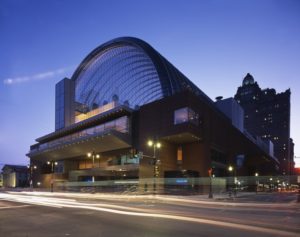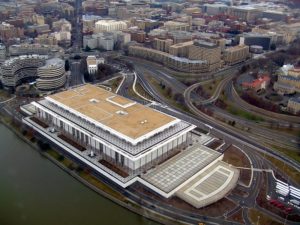Where’s the Brief?
In North America, theatre consultants are often introduced to a prospective new project via a Request for Proposal – typically, a voluminous package of information that was prepared and circulated by a government or private purchasing authority for the purpose of inviting potential design firms to submit bids on the job, with the hope of being short-listed, and eventually – hopefully – designing the project.

It is important to understand the programming expectations for a facility. Kimmel Center Concert Hall
The Request for Proposal (RFP) for a new project contains many pages of instructions on what/when/how to submit, a description of the selection process, the evaluation criteria, the project schedule, a sample of the proposed design contract, and, finally, an all-too-succinct description of the project. In some cases, this project description can be quite specific, but in many RFPs, the project description lacks detail on exactly the kind of information theatre consultants – and other members of the design team – need most, e.g., what is the intended purpose of the performance space(s), what types of performances are envisioned, how flexible will the staging and seating be, etc. As a result, design teams often propose for a very different building than they actually end up designing. The resulting disconnect can have a detrimental effect on the final design.
Outside of North America, this disconnect is often successfully bridged by an additional document that is included in the introductory RFP package: The Brief.
In the context of the architectural design process, The Brief is a statement of the fundamental design and operational requirements that are expected by the Owner. The Brief is recognized internationally as providing the design team with the highest level of information, clearly from the outset, of the intent of the proposed project. In North America, this document is typically referred to as the Program, a term that has various and sometimes confusing connotations. Most Program documents are heavy on WHAT but light on WHY. They tend to lean heavily on the Facilities Program (or Space Program), a matrix listing of all required spaces, including sizes, quantities, adjacencies, and technical requirements. A Brief, on the other hand, can contain volumes of supportive information explaining WHY this facility is being built; the listing of spaces is a minor component of the whole.
The overall design criteria included in The Brief can provide the big-picture projections of budget, gross square footage, site and zoning restrictions, and parking requirements. Tangible design elements can be listed to explain the primary components of the proposed building, including the seat count and type of performance space or spaces, whether the building will include scenery and costume shops, dressing rooms, rehearsal rooms, orchestra pit, orchestra shell, media studio, or an art gallery, for instance. Additional building components can be described including food catering support, loading dock capacity, storage expectations, administrative office requirements and other special auxiliary spaces intended for the operation of the building.
Intangible, but important, design elements may include a list of the proposed users of the facility, the types of presentations, expectations for acoustic quality, the quantity and level of training of the technical staff, and the expected level of sophistication for performance lighting, rigging, and audio-visual systems. Obviously, a School of Music will have significantly different requirements than a resident professional theatre company, and a renovation may require a different approach than new construction.
When a Brief is well prepared, the projected gross square footage will correspond to the sum of the spatial requirements of the intended overall building components. The projected construction budget will correspond to the projected gross square footage of construction. Cost escalations and allowances will be identified and applied to a realistic design and construction schedule.
The preparation of a Brief for a performance facility is rarely handled by a single entity and may require coordinated input from a professional Theatre Consultant and an Arts Management Consultant, both working in conjunction with a qualified cost consultant with a background and current experience in performing arts facility costing. Whichever professional consultants are involved, a truly comprehensive Brief will also require the deep participation of Owner and User representatives: artistic and administrative leadership, production managers, technical department heads, stage managers, audience services managers, and safety and health managers.
Due to the myriad considerations that are part of the design and construction of a performance facility, the preparation of an effective Brief will require the expenditure of time and financial resources prior to the issue of the Request for Proposal, but the result will be a much more informed proposal process with fewer questions, more clarity, and a sharper set of RFP responses that will potentially save both the Owner and the design team valuable time and money.
Generally, the best time to prepare an effective design Brief is at the conclusion of a Needs Assessment and Business Plan feasibility study, most often conducted by an Arts Management Consultant. It is at this point that the Owner and the potential users are most clearly focused on the conceptual design of the proposed new or renovated facility. Perhaps the time has come to make the Brief a regular part of the Request for Proposals in the North American market. The result could just be performing arts facilities that are more finely tuned to the precise needs of the Owners, Users, and their markets.
By Robert Long, FASTC and Robert Shook, FASTC
Disclaimer: Any views or opinions expressed in this article are solely those of the author and do not necessarily represent those of the American Society of Theatre Consultants. This article is for general information only and should not be substituted for specific advice from a Theatre Consultant, Code Consultant, or Design Professional, and may not be suitable for all situations nor in all locations.



